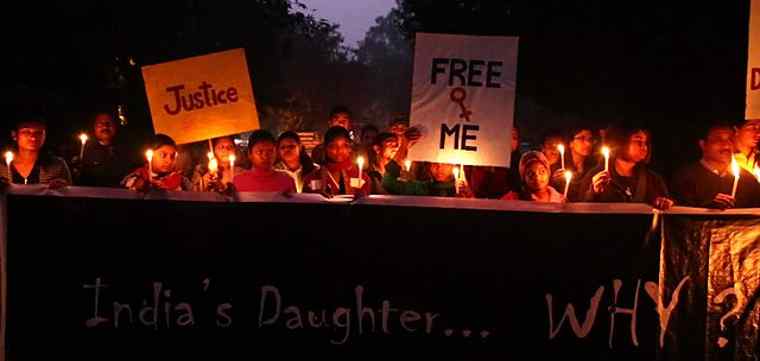
British director Leslee Udwin interviewed one of the rapists Mukesh Singh in jail to make the documentary, India’s Daughter.
By Rakesh Raman

The one-hour documentary, India’s Daughter, tells the story of the gang rape and murder of a 23-year-old student on a moving bus in India’s capital New Delhi. The rape that happened in 2012 triggered countrywide protests while the rapists locked in jail are facing death sentence.
British director Leslee Udwin interviewed one of the rapists Mukesh Singh in jail, other rapists’ family members, defense lawyers, victim’s parents and others to make the documentary, which was scheduled for release on Sunday.
However, fearing protests on streets, the Indian government moved the court and under court order banned the screening of the film in India. The government also said that it will take steps to ban the film in other countries too.
BBC didn’t care about the Indian government’s gag orders. Instead of showing India’s Daughter on the planned day, International Womens’ Day this Sunday, it released it today for public viewing on BBC Four Storyville programme. BBC said the documentary’s release is being advanced as it’s receiving huge public interest.
[ Also Read: Kaum De Heere Film Banned by the Government in India ]
The mere thought of banning India’s Daughter film raises some serious questions about the media understanding of Indian politicians, most of whom are illiterate and/or foolish. They thought people in India will not be able to watch the film if it is banned.
They failed to understand a simple thing that they can only restrain local TV channels which can be tamed with a court order. But what about the Internet? Can they control it? No way.
So, now with the ban order, the film got huge pre-release publicity and it’s freely available on a slew of Web properties including the social video-sharing site YouTube. In fact, it’s going viral on social media.
[ How Indian Rulers Abuse Human Rights in the Digital Space ]
Viral is a digital media phenomenon where after watching a film or video, social media users share it with their friends on the networks such as Facebook, Twiiter, Linkedin, asking them to watch it. So, it spreads like virus.
While the Indian government wanted to curb the film’s viewing with its directive, India’s Daughter is being watched by millions of people all around the world – including India.
Why did Indian government ban India’s Daughter?
There was no reason for the government to ban the film. It’s a pretty innocuous film, which has told the rape story from all possible angles. And even the raped girl’s parents have fully participated with their views.
The views of the rapist are already in the public domain, as different publications in India and abroad have published a number of stories about the film during the past one week or so.
[ Delhi Rapist: Girl Was Responsible for Her Death ]
Even the girl’s parents said to a local TV channel that they are not bothered if India’s Daughter is shown or banned. Plus, the two defense lawyers interviewed in the documentary have expressed their views multiple times in the past. They repeated the same for Leslee Udwin’s India’s Daughter.
Then what exactly was the Indian government trying to achieve by banning the film? The government tried to hide its own incompetence that it’s not capable to control rapes in the country. The ban order was basically a bureaucratic hogwash that the government used to save its own skin. With this move, it tried to ostensibly show that it’s concerned about rapes, etc.
[ No Democracy in India. It Is Parliamentary Dictatorship. ]
But one of the lawyers in the documentary asked a valid question: If the government really wants to check the incidents of rapes and similar crimes and punish the culprits, why can’t it begin the process from the Indian Parliament where almost half the Members of Parliament (MPs) are facing similar charges?
In fact, the Indian government is not serious at all to deal with this menace. Women’s safety is not Indian government’s priority. It’s manifested in the fact that the number of rape cases in Delhi had almost doubled in a year after the gang rape and murder of the girl in Delhi bus.
According to government figures, there were 1,330 rapes in Delhi in the first 10 months of 2013 as compared with 706 for the whole of 2012.
It’s not only in Delhi, but the rape cases are increasing all over the country and now India is among the top 10 countries of the world in terms of number of rapes.
According to the National Crime Records Bureau, 24,923 rape cases were reported across India in 2012. But the number will be much higher, as most cases are not reported to the police by rape victims. Estimates suggest that a new case of rape is reported every 22 minutes in India.
Meanwhile, filmmaker Leslee Udwin has asked the Indian Prime Minister, Narendra Modi, to intervene and allow the film’s release in India, as the local authorities have banned the domestic broadcast of India’s Daughter.
By Rakesh Raman, the managing editor of RMN Company
You also can read: More Articles by the RMN Editor, Rakesh Raman
Photo courtesy: BBC



